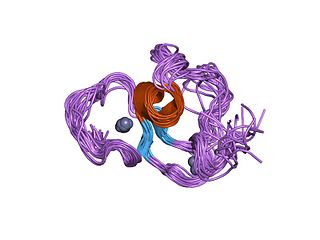
Histone methyltransferases (HMT) are histone-modifying enzymes, that catalyze the transfer of one, two, or three methyl groups to lysine and arginine residues of histone proteins. The attachment of methyl groups occurs predominantly at specific lysine or arginine residues on histones H3 and H4. Two major types of histone methyltranferases exist, lysine-specific and arginine-specific. In both types of histone methyltransferases, S-Adenosyl methionine (SAM) serves as a cofactor and methyl donor group.
The genomic DNA of eukaryotes associates with histones to form chromatin. The level of chromatin compaction depends heavily on histone methylation and other post-translational modifications of histones. Histone methylation is a principal epigenetic modification of chromatin that determines gene expression, genomic stability, stem cell maturation, cell lineage development, genetic imprinting, DNA methylation, and cell mitosis.
Histone methylation is a process by which methyl groups are transferred to amino acids of histone proteins that make up nucleosomes, which the DNA double helix wraps around to form chromosomes. Methylation of histones can either increase or decrease transcription of genes, depending on which amino acids in the histones are methylated, and how many methyl groups are attached. Methylation events that weaken chemical attractions between histone tails and DNA increase transcription because they enable the DNA to uncoil from nucleosomes so that transcription factor proteins and RNA polymerase can access the DNA. This process is critical for the regulation of gene expression that allows different cells to express different genes.
Demethylases are enzymes that remove methyl (CH3) groups from nucleic acids, proteins (particularly histones), and other molecules. Demethylases are important epigenetic proteins, as they are responsible for transcriptional regulation of the genome by controlling the methylation of DNA and histones, and by extension, the chromatin state at specific gene loci.

The PHD finger was discovered in 1993 as a Cys4-His-Cys3 motif in the plant homeodomain proteins HAT3.1 in Arabidopsis and maize ZmHox1a. The PHD zinc finger motif resembles the metal binding RING domain (Cys3-His-Cys4) and FYVE domain. It occurs as a single finger, but often in clusters of two or three, and it also occurs together with other domains, such as the chromodomain and the bromodomain.

Lysine-specific histone demethylase 1A (LSD1) also known as lysine (K)-specific demethylase 1A (KDM1A) is a protein in humans that is encoded by the KDM1A gene. LSD1 is a flavin-dependent monoamine oxidase, which can demethylate mono- and di-methylated lysines, specifically histone 3, lysines 4 and 9. This enzyme can have roles critical in embryogenesis and tissue-specific differentiation, as well as oocyte growth. KDM1A was the first histone demethylase to be discovered though more than 30 have been described.

Histone-modifying enzymes are enzymes involved in the modification of histone substrates after protein translation and affect cellular processes including gene expression. To safely store the eukaryotic genome, DNA is wrapped around four core histone proteins, which then join to form nucleosomes. These nucleosomes further fold together into highly condensed chromatin, which renders the organism's genetic material far less accessible to the factors required for gene transcription, DNA replication, recombination and repair. Subsequently, eukaryotic organisms have developed intricate mechanisms to overcome this repressive barrier imposed by the chromatin through histone modification, a type of post-translational modification which typically involves covalently attaching certain groups to histone residues. Once added to the histone, these groups elicit either a loose and open histone conformation, euchromatin, or a tight and closed histone conformation, heterochromatin. Euchromatin marks active transcription and gene expression, as the light packing of histones in this way allows entry for proteins involved in the transcription process. As such, the tightly packed heterochromatin marks the absence of current gene expression.

Histone cluster 2, H3, pseudogene 2, also known as HIST2H3PS2, is a human gene.

Euchromatic histone-lysine N-methyltransferase 2 (EHMT2), also known as G9a, is a histone methyltransferase enzyme that in humans is encoded by the EHMT2 gene. G9a catalyzes the mono- and di-methylated states of histone H3 at lysine residue 9 and lysine residue 27.

C-terminal-binding protein 2 also known as CtBP2 is a protein that in humans is encoded by the CTBP2 gene.

Lysine-specific demethylase 5A is an enzyme that in humans is encoded by the KDM5A gene.

Lysine-specific demethylase 4A is an enzyme that in humans is encoded by the KDM4A gene.

Lysine-specific demethylase 2A (KDM2A) also known as F-box and leucine-rich repeat protein 11 (FBXL11) is an enzyme that in humans is encoded by the KDM2A gene. KDM2A is a member of the superfamily of alpha-ketoglutarate-dependent hydroxylases, which are non-haem iron-containing proteins.

Lysine-specific demethylase 5C is an enzyme that in humans is encoded by the KDM5C gene. KDM5C belongs to the alpha-ketoglutarate-dependent hydroxylase superfamily.

Histone-lysine N-methyltransferase 2D (KMT2D), also known as MLL4 and sometimes MLL2 in humans and Mll4 in mice, is a major mammalian histone H3 lysine 4 (H3K4) mono-methyltransferase. It is part of a family of six Set1-like H3K4 methyltransferases that also contains KMT2A, KMT2B, KMT2C, KMT2F, and KMT2G.

Lysine-specific demethylase 5B also known as histone demethylase JARID1B is a demethylase enzyme that in humans is encoded by the KDM5B gene. JARID1B belongs to the alpha-ketoglutarate-dependent hydroxylase superfamily.

Lysine-specific demethylase 4B is an enzyme that in humans is encoded by the KDM4B gene. KDM4B belongs to the alpha-ketoglutarate-dependent hydroxylase superfamily.

Lysine-specific demethylase 6A also known as Ubiquitously transcribed tetratricopeptide repeat, X chromosome (UTX), is a protein which in humans is encoded by the KDM6A gene. It belongs to the 2-oxoglutarate (2OG)-dependent dioxygenase superfamily.

Euchromatic histone-lysine N-methyltransferase 1, also known as G9a-like protein (GLP), is a protein that in humans is encoded by the EHMT1 gene.

The human KDM2B gene encodes the protein lysine (K)-specific demethylase 2B.

Lysine demethylase 6B is a protein that in humans is encoded by the KDM6B gene.















